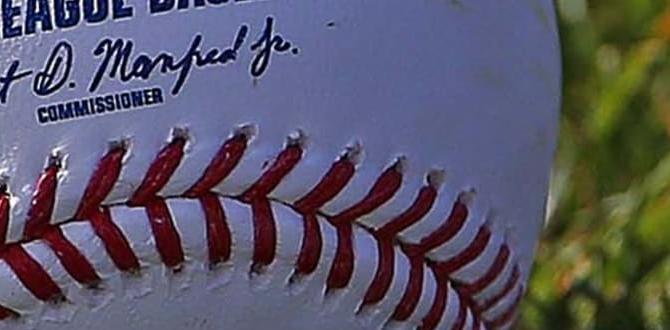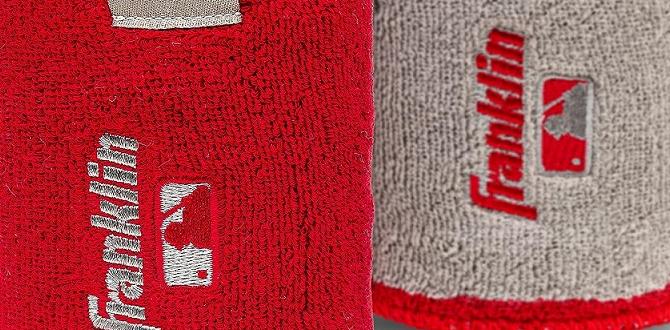Quick Summary:
Properly sizing your Champro catcher’s throat guard is crucial for maximum protection and comfort, preventing injury. This guide breaks down how to measure and fit your throat guard to your mask and head for a secure, effective fit.
Welcome, ballplayers! John P. Miller here from FriskMode. If you’re stepping behind the plate as a catcher, you know protecting that throat is non-negotiable. A loose or ill-fitting throat guard isn’t just uncomfortable; it’s a serious safety risk. We’ve all seen those moments where a wild pitch or foul tip has a catcher wincing. This guide is all about making sure your Champro catcher’s throat guard fits like a glove, keeping you safe and focused on the game. We’ll walk through every step, making sure you get that perfect, secure fit without any fuss. Ready to gear up with confidence?
Champro Catchers Throat Guard Sizing: Essential Guide
Why Throat Guard Fit Matters for Catchers
As a catcher, you’re right in the action, facing pitches hurled at incredible speeds. Your catcher’s mask is your primary shield, but a throat guard is a vital extension of that protection. It’s designed to absorb impacts and prevent those dangerous, direct hits to the throat area from foul balls and errant pitches. However, this protection is only effective if the throat guard is sized and fitted correctly. An improperly sized guard can shift, move, or even leave unprotected gaps, turning a piece of safety equipment into a potential hazard. Let’s dive into how to ensure your Champro throat guard offers the best possible defense.
Understanding Champro Throat Guard Models
Champro offers a range of catcher’s gear, and their throat guards are designed to integrate seamlessly with their masks. While many throat guards follow similar principles, understanding specific Champro designs can help. Most Champro throat guards are attachments designed to clip or screw onto the existing cage of a catcher’s mask. The key is compatibility between the throat guard and the mask model. Some are universal, while others are tailored for specific mask lines. Always check the product description to ensure it’s designed for your particular Champro mask.
Common Champro Throat Guard Attachment Methods
- Clip-on Systems: These are the most common and usually the easiest to install. They feature adjustable clips that grip the mask’s bars securely.
- Screw-in Systems: Some models use small screws to firmly fasten the guard to pre-drilled holes on the mask. This offers a very secure, permanent attachment.
- Velcro Straps: Less common for rigid throat guards, but some flexible or specialized models might use industrial-strength Velcro for attachment.
Measuring for Your Champro Throat Guard
Getting the right size isn’t just about the throat guard itself; it’s about how it fits with your mask and, ultimately, your head. Here’s how to measure accurately:
Step 1: Measure Your Catcher’s Mask
Before you even look at a throat guard, you need to know the dimensions of the mask it will attach to. The most critical measurement is the distance between the front bar of the mask and the chin. This will help determine how far down the throat guard needs to extend.
What you’ll need:
- Flexible measuring tape or a string and ruler
How to measure:
- Place the catcher’s mask on a stable surface or have someone hold it securely.
- Measure from the inside of the front, horizontal bar of the mask directly down to the point where the mask’s chin protector typically rests on your chin.
- Record this measurement. This gives you a baseline for how much coverage you need.
It’s also helpful to measure the width of the mask from side to side, though throat guards are usually designed to fit standard mask widths.
Step 2: Measure Your Neck/Throat Area (Indirectly)
You don’t actually need to measure your neck circumference for most throat guards. Instead, the goal is to ensure the guard sits comfortably against your throat when the mask is on, without being too tight or too loose. The length and angle of the guard, combined with its attachment to the mask, are what achieve this fit.
Step 3: Consider Mask-to-Throat Guard Compatibility
This is where research comes in. Champro throat guards are often designed for specific mask series. For example, a throat guard designed for a Champro youth mask might not fit a Champro adult pro-style mask. Check the product listing for recommended mask compatibility.
Key Compatibility Checkpoints:
- Model Series: Does the throat guard explicitly state it fits your Champro mask model (e.g., “fits Champro Pro-Plus Mask”)?
- Mask Cage Design: Look at the bar spacing and shape of your mask’s cage. Some throat guards have clips designed for specific bar thicknesses or shapes.
- Attachment Points: If your mask has specific pre-drilled holes for a throat guard, ensure the guard you’re buying has corresponding attachment points.
Champro Catchers Throat Guard Sizing Chart (General Guidelines)
While specific “sizing charts” for throat guards are rare because they are typically one-size-fits-most (when attached to a compatible mask), here are general guidelines based on typical mask and player sizes. The “size” of a throat guard is often determined by its length and how it’s designed to extend from the mask.
It’s crucial to understand that most throat guards are adjustable to some degree, either through their clip positioning or the inherent flexibility of the material. The primary “sizing” aspect is ensuring it matches the mask it’s intended for.
| Player / Mask Type | Throat Guard Length Considerations | Fit Notes |
|---|---|---|
| Youth (Ages 8-12) | Shorter extension from mask; designed for smaller mask cages. | Must connect securely to youth-sized masks without excessive overhang or looseness. |
| Intermediate / Junior (Ages 13-15) | Medium extension; suitable for intermediate mask sizes. | Should provide firm fit on mid-sized masks; check for adjustability. |
| Adult / Senior (Ages 16+) | Longer extension from mask; designed for standard adult mask cages. | Ensures coverage for adult head and mask sizes; look for robust attachment. |
Important Note: Always prioritize the manufacturer’s stated compatibility over generic charts. Champro’s website or product packaging is the best source for confirmed fitment. A great resource for understanding general baseball equipment sizing is USA Baseball’s Equipment Standards page, which offers foundational knowledge on product specifications.
How to Attach and Adjust Your Champro Throat Guard
Once you have a compatible throat guard, attaching and adjusting it properly is key to optimal protection and comfort. This process is usually straightforward.
Step-by-Step Installation Guide
- Prepare Your Mask: Ensure your catcher’s mask is clean and free of debris. If it’s a screw-in type, identify the pre-drilled attachment points.
- Position the Throat Guard: Hold the throat guard in the position it will sit, usually below the chin guard of the mask, extending downwards towards the chest.
- Attach According to Type:
- For Clip-on Guards: Locate the clips on the throat guard. Align them with the appropriate bars on your catcher’s mask cage. Gently but firmly snap or slide the clips onto the bars. Ensure all clips are fully engaged.
- For Screw-in Guards: Align the throat guard’s attachment points with the pre-drilled holes on the mask. Insert the provided screws (often small, flat-head screws) and tighten them using a screwdriver. Tighten them enough to secure the guard but avoid overtightening, which could strip the threads or damage the mask/guard.
- Check for Security: Gently tug on the throat guard in various directions. It should feel firmly attached to the mask and should not wobble or shift significantly.
- Test the Fit (On Your Head): Put on your catcher’s mask and throat guard.
- Does the throat guard rest comfortably against your throat area without pinching or feeling too loose?
- Is there adequate coverage from the bottom of the mask to the top of the throat guard?
- Can you breathe and speak naturally?
- When you nod your head or move, does the guard stay in place?
- Adjust if Necessary:
- Most clip-on guards allow slight adjustment by repositioning the clips on the mask bars.
- If your guard has an adjustable strap or screw mechanism for fine-tuning the angle or position, use that now.
- If the guard is too long or too short for your mask and head combination, you may need a different model or size of throat guard.
Advanced Fit Considerations and Tips
Beyond basic attachment, a few extra steps and considerations can optimize your throat guard’s performance and comfort.
- Chin Strap Interaction: Ensure the throat guard doesn’t interfere with your mask’s chin strap or cause discomfort against your jawline.
- Breathing Space: The guard should allow you to take deep breaths without feeling constricted, especially during strenuous play.
- Movement and Flexibility: While a secure fit is paramount, some flexibility in the guard material can prevent it from feeling rigid or uncomfortable.
- Material Matters: Champro throat guards are typically made from durable plastics or high-impact polymers. These materials offer great protection. Ensure the material is intact and free from cracks.
- Post-Impact Check: After any significant ball impact or hard fall, inspect your throat guard and its attachments to ensure they haven’t been compromised.
Protective Gear Standards and Resources
Understanding safety standards for baseball equipment can provide additional confidence. Organizations like the National Federation of State High School Associations (NFHS) and leagues like Little League International often have specific rules and recommendations for catcher’s gear, including throat protection. These resources can guide you on the essential features and protection levels expected from quality gear.
For general information on equipment safety and testing, you can refer to resources like the ASTM International Committee F08 on Sports and Recreation wrote standards for athletic equipment. While not always directly accessible by the public for free, their existence signifies a commitment to safety in sports gear development.
FAQ: Your Champro Throat Guard Questions Answered
Here are some common questions beginner catchers and their parents have about Champro throat guards.
Q1: How do I know if my Champro throat guard is too short?
A1: If there’s a noticeable gap between the bottom of your catcher’s mask chin protector and the top of the throat guard, or if the guard doesn’t feel like it’s adequately covering your throat area, it might be too short for your mask or head size.
Q2: Can I use a throat guard designed for another brand of mask?
A2: While some universal throat guards might fit, it’s always best to use a Champro throat guard with a Champro mask for guaranteed compatibility and optimal fit. If you must use a different brand, compare attachment mechanisms and measurements very carefully.
Q3: How do I clean my Champro throat guard?
A3: Most plastic or polymer throat guards can be cleaned with mild soap and water. A gentle scrub with a cloth and a rinse should suffice. Ensure it’s fully dry before reattaching it to your mask.
Q4: My throat guard feels a bit loose. What can I do?
A4: First, double-check that all clips are fully engaged or screws are tightened. If it’s a clip-on mechanism, try repositioning the clips on different bars of the mask cage for a snugger fit. If it remains loose, you might need a different model or a guard specifically designed for your mask.
Q5: Should my throat guard touch my throat directly?
A5: Yes, the throat guard should rest comfortably against your throat area to provide effective protection. It shouldn’t be so tight that it restricts breathing or so loose that it shifts significantly. The fit should feel secure and protective.
Q6: What is the difference between an adult and youth Champro throat guard?
A6: The primary difference is typically length and the size of the mask they are designed to fit. Youth guards are generally shorter and designed for smaller masks, while adult guards are longer and made for standard adult-sized mask cages.
Conclusion
Safely and effectively commanding the catcher’s position starts with the right gear, and a properly sized Champro catcher’s throat guard is a critical component of that setup. By taking the time to measure your mask, understand compatibility, and follow the installation steps, you ensure that this vital piece of equipment provides the maximum protection it’s designed for. Remember, a secure fit means less distraction, more confidence, and ultimately, better performance behind the plate. Keep practicing, stay safe, and embrace your role as the anchor of your team!




